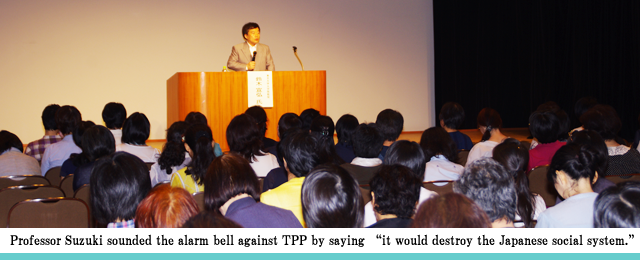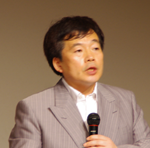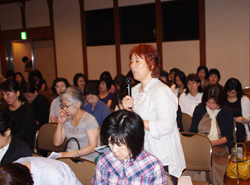Our Buying Power Sends Signals to Society

Every July, at the time of committee member rotation, the Consumption Committee of the Seikatsu Club Consumers' Co-operative Union (SCCCU) holds a conference, at which a priority issue for the year is studied in depth. This year's theme was "The Power of our Collective Purchase." It provided an opportunity for the members to reexamine the significance of their collective purchase before their united action planned for the autumn. In the first half of the conference, Professor Norihiro Suzuki (Graduate School, University of Tokyo) gave a speech entitled "TPP and our Livelihood." In the latter half, proposals and presentations were made regarding SCCCU’s consumer materials* development, which is an integral part of our collective purchase. (Posted on August 1).
* Seikatsu Club uses the term “consumer materials” to refer to the products for which members employ their collective power of purchase, since items are not “commercial goods” for sale, but are for use-value.
TPP would ruin the Japanese Social System
 "Some people argue that it is economically efficient if 1% of people become wealthier by taking advantage of a deregulated market while the remaining 99% suffer from the same deregulation and are unable to obtain sufficient food and health care.” This is how Nobuhiro Suzuki (Professor of Economics at the Graduate School of the University of Tokyo) explained the nature of TPP (Trans-Pacific Partnership). He also pointed out that “The government of the United States is now trying hard to implement this sort of efficiency under TPP.”
"Some people argue that it is economically efficient if 1% of people become wealthier by taking advantage of a deregulated market while the remaining 99% suffer from the same deregulation and are unable to obtain sufficient food and health care.” This is how Nobuhiro Suzuki (Professor of Economics at the Graduate School of the University of Tokyo) explained the nature of TPP (Trans-Pacific Partnership). He also pointed out that “The government of the United States is now trying hard to implement this sort of efficiency under TPP.”
The Japanese government hinted at the possibility that rice and dairy products might be exempted from the TPP obligation of zero tariffs. Professor Suzuki clarified that there are no exemptions, as the parties to the TPP have only agreed on a seven-year moratorium. Besides tariffs, TPP aims at eliminating non-tariff trade barriers to allow companies to act more freely. “Domestic systems to protect people’s livelihoods can be targeted as trade barriers,” Professor Suzuki added, “The Japanese social system itself is at risk of being destroyed.”
Strengthening Networks among Cooperatives
The price of Japanese rice has decreased by half in the last decade due to reduced domestic support. It is estimated that further liberalization of the rice trade brought about by joining TPP would lower Japan’s food self-sufficiency rate to 13%. What will Japanese people eat if that happens? “We should discuss this issue seriously,” Professor Suzuki pointed out, and said there need to be flexible economic partnerships with Asian countries and the European Union which allow for the differences between them.
"We have to protect our food by ourselves," he continued. "If you only want food to be cheaper, you will shorten your life. It will also place a large burden on future generations. Producers and consumers need to discuss how to set appropriate prices that will make everyone happy in the long term.” He then gave some examples of voluntary projects where people share the value of farming and access to food as the basis of a community.
“If we have more projects of this kind, it will create a foundation for Japanese agriculture. Farmers would be able to compete with foreign produce in spite of disadvantageous conditions. I hope that cooperatives will play an important role as coordinators who lead the trend. When this becomes widespread across the country, Japanese agriculture will grow to be truly competitive.”
Toward Decision Making on Processed Food Categories
 SCCCU is now reviewing the following points about each category of its consumer materials:
SCCCU is now reviewing the following points about each category of its consumer materials:
1. Market trend and problems of products in the market,
2. Achievements and challenges for collective purchase, and
3. Development policy.
According to a government survey on household expenditure, the total amount of money spent on foodstuffs has continued to decrease and now stands at 80.7% of the peak in 1992. At the same time, the number of households is growing due to the increase of single-person households and the ageing population. In addition, expenditure on cereals, vegetables, and meat, which need to be cooked at home, continues to decline, while more money is spent on easy-to-serve food such as retort pouch foods, ready-made meals, boxed lunches, and prepared food. 48% of household expenditure on food is spent on processed food.
On the other hand, 39% of the total expenditure of SCCCU members on collective purchase is spent on processed food. However, “The percentage is becoming larger because less time is spent on cooking due to the increase of working women, families with fewer children, and the ageing population,” says Yasuyuki Shimura, Director of the Processed Food and Fishery Division, SCCCU. At the same time, SCCCU’s consumer materials used to have clear advantages in quality and were also competitive in price. “The more highly processed the food is, the less we see the advantages of the raw materials used to make it. Price pressure is also a challenging issue,” said Mr. Shimura.
In the above-mentioned circumstances, a basic concept for future decision making was proposed. This was outlined as “highly valued raw materials and more ready-made meal product lines---raw materials and processed foods are inseparable parts of our food self-sufficiency.”
Specific policies for the development of ready-made meals were proposed as follows:
- The essential part of consumer materials development is “to impress members with the delectability of the food,” taking into account the principles of “safety, health and the environment,” fair prices, and freedom from exploitation.
- It is necessary to promote collaboration between the food industry and farming sector in order to raise the food self-sufficiency rate, because these two sectors are closely connected with one another.
- Taking into account the current global food situation, SCCCU positions the development of processed food as a means to increase the food self-sufficiency rate and support sustainable agriculture, dairy farming, and fisheries in Japan.
Consumer Materials Development with the Mass Participation of Members in Kanagawa
 Atsuko Iida, Board Member of the Shonan Seikatsu Club Consumers’ Co-operative, gave a presentation about participatory consumer materials development in Kanagawa as a showcase for future plans regarding SCCCU member participation in its consumer materials development.
Atsuko Iida, Board Member of the Shonan Seikatsu Club Consumers’ Co-operative, gave a presentation about participatory consumer materials development in Kanagawa as a showcase for future plans regarding SCCCU member participation in its consumer materials development.
Ms. Iida outlined the basic principles of the Kanagawa’s “Consumers Materials Development Project” by saying, “Our consumer material development and improvement activities can be described as a way to exercise consumer power. We proactively and cooperatively create goods which are essential and useful for our daily life. Our organization is also activated by our consumer materials development. These activities are not led by only a limited number of members, but are participated in by a large number of members. When we work with our members, we also ask them to purchase and consume more of these materials.”
 To wrap up the conference, Izumi Ueda, chairperson of the SCCCU Consumption Committee said, “Professor Suzuki has encouraged us to tackle the big issue of TPP and helped us realize that we are going in the right direction. The policy on each category of processed foods was proposed today for the first time. I hope that many meetings will be held at the local level to discuss our consumer materials development from the viewpoint that our collective purchases will send an important message to society.”
To wrap up the conference, Izumi Ueda, chairperson of the SCCCU Consumption Committee said, “Professor Suzuki has encouraged us to tackle the big issue of TPP and helped us realize that we are going in the right direction. The policy on each category of processed foods was proposed today for the first time. I hope that many meetings will be held at the local level to discuss our consumer materials development from the viewpoint that our collective purchases will send an important message to society.”
生活クラブをはじめませんか?
42万人が選ぶ安心食材の宅配生協です
ウェブ加入限定 無料プレゼント






